
Editor of this issue: Thomas Remeikis
 |
www.lituanus.org |
|
Copyright © 1963 Lithuanian
Students Association, Inc.
Vol. 9, No.2 - 1963
Editor of this issue: Thomas Remeikis |
|
Viktoras VIZGIRDA

Viktoras Vizgirda occupies one of the most prominent positions in present-day Lithuanian art. To fully understand and appreciate his importance we would require a study of wider perspective, analyzing the esthetic aspects of creativity and indicating the role of this artist in the evolution of Lithuanian art. Because of the limited scope of this article, however, it is necessary to restrict the discussion to a few points of major importance.
By age and by artistic conception Vizgirda belongs to the first generation of artists of independent Lithuania. The most talented members of this generation clearly and unquestionably committed themselves to joining in the tradition of Western art and declared war on the deeply rooted academism; at that time, this was an unusually heroic act. Except for the earlier single-handed attempt at a revolution by M. K. Čiurlionis, this was the first active group-revolution in the history of Lithuanian art. It initiated a dialogue between the old and the young generations, which greatly influenced the further development of Lithuanian art.
Lithuanian artists of the older generation, educated in Russian or Polish academies of art, stubbornly clung to the naive academism and sentimental realism characteristic of Russian "Wanderers" (peredvizhniki). In their eyes, impressionism and the artistic theory of subsequent movements merely constituted a crude crime against the "eternal" tenets of art. Moreover, the bohemian attitudes acquired and brought in from the Russian and Polish schools were still uppermost in this generation's understanding of art; this was completely foreign to the younger generation. Having control of education and aided by conservative criticism and government institutions, the older artists were quite successful in defending their positions; they finally surrendered only at the start of the second World War.
Thus, Vizgirda and his contemporaries (Samuolis, Gudaitis, Valeška, et al.) were faced with an extremely difficult task: with the aid of dissidents among the older generation (Galdikas, Vienožinskis, et al.) they had to survive physically and to fill the great void in creativity that was caused by the older generation's bypassing of the modern artistic movements. Vizgirda made one of the greatest contributions in this task.
Vizgirda was born in Domininkonys, Lithuania, in 1904 and studied art in the Kaunas Academy of Art under J. Vienožinskis, who was at that time almost the only supporter of new talents and of artists who were searching for new means of expression. Having graduated in 1926, he and other revolutionary-minded artists of his generation formed a group named "Ars"; its main purpose was to be the utilization of both the centuries-old tradition of Lithuanian folk art and of the modern art techniques in endowing Lithuanian art with a new and completely Western quality. Later Vizgirda left for Paris, where he studied with the famous artist and art theorist, André Lhote. Between 1940 and 1944 he taught at the Vilnius Academy of Art and was its director for a part of that period. From 1946 to 1949 he taught at the École des Arts et Metiers in Freiburg, Germany. At present Vizgirda resides in Boston.
It is difficult to classify Vizgirda artistically, or to restrict him within a particular school of art. His artistic "roots" should perhaps be sought out in the tradition of Lithuanian folk sculpture and painting, in Gauguin, and in the later works of certain French Fauvists. The latter group's influence is quite evident in Vizgirda's conception of the relationship of color and form, which is based on the functional variability of these elements. His painting is essentially coloristic; color is its absolute center, completely overshadowing the somewhat hazy element of contents. Another outstanding characteristic of Vizgirda's painting is the emotional experience of reality and a deeply individualistic approach to art. Vizgirda is an artist from within; rather than accenting the visual idea of a model, he emphasizes its artistic aspects, the "intimate artisticness" that is especially noticeable in his self-portraits and still-life paintings. Even his landscapes (the type of painting most often found among his works) are in a certain sense self-portraits of the author's moods. In these works nature is altered and individualized to such an extent, that very often their identifying titles could be replaced by catalogue numbers.
In recent years Vizgirda has also worked with stained glass, achieving noteworthy results.
During more than forty years of creative work (Vizgirda began to paint when he was barely ten years old), his works have been widely accepted and acclaimed both in his native country and in other parts of the world. In addition to Lithuania, Vizgirda's works have been exhibited in Estonia, Latvia, Holland, Germany, Canada, and the United States.
•
In conclusion we may mention a small, but in our estimation quite important detail that characterizes Vizgirda. Even in the years of the absolute dictatorship of abstractionism (1950-1960), when not only the youth but also the aged veterans of art and the "Sunday-painters" moved into abstract art, Vizgirda staunchly remained true to his own esthetics and serenely continued his work. This statement is not meant as an attack on abstractionism; is is merely intended to serve as further proof of this artist's creative integrity and courage in maintaining his individuality, even though this may not be in accord with the dictates of latest fashion.
Alfonsas NYKA-NILIŪNAS
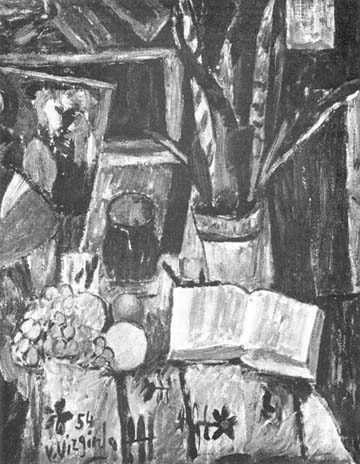
STiLL LIFE WITH BOOK • 1954
• 30"x24"
Collection Dr. J. Girnius, Boston
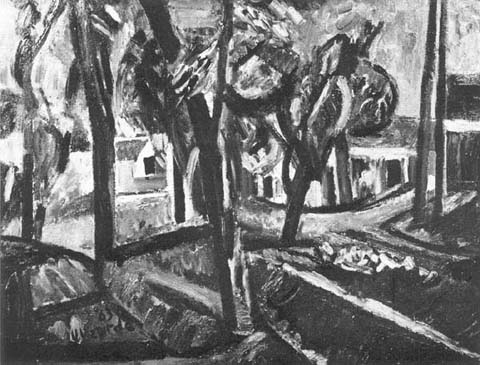
TREE-SHROUDED CROSSROAD • 1963 • 30"x40"
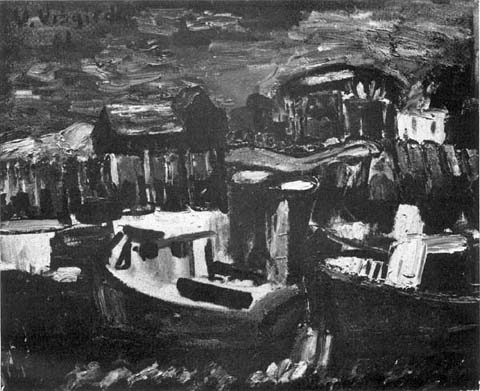
ROCKPORT, CAPE ANN • 1961 • 24"x30"
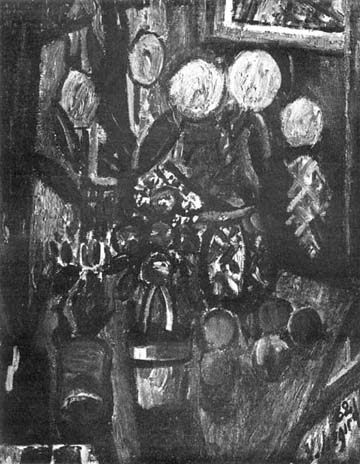
STILL LIFE • 1962 • 37"x29"
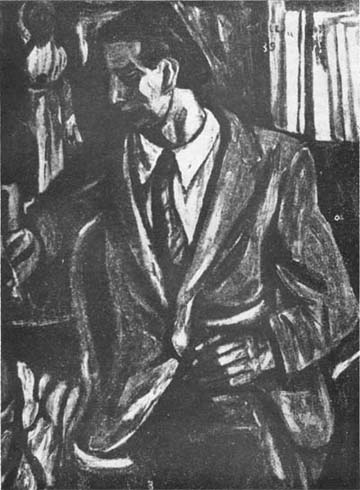
PORTRAIT OF ARTIST V. PETRAVIČIUS • 1939 • 45¾"x35"
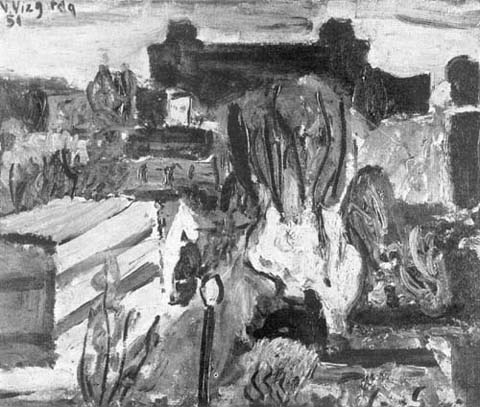
SPRING IN BOSTON • 1951
• 18"x22"
Collection Mrs. M. Ambrozaitienė, Chicago
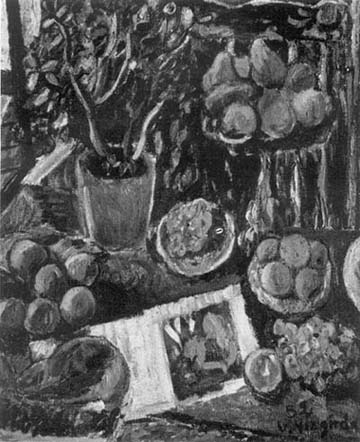
FRUITS AND FLOWERS • 1952
• 34"x28"
From Čiurlionis Gallery, Chicago
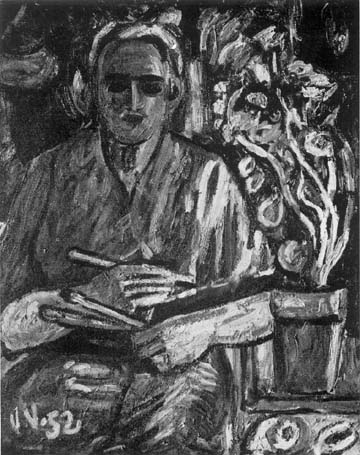
PORTRAIT OF ARTIST • 1952 • 30"x24"
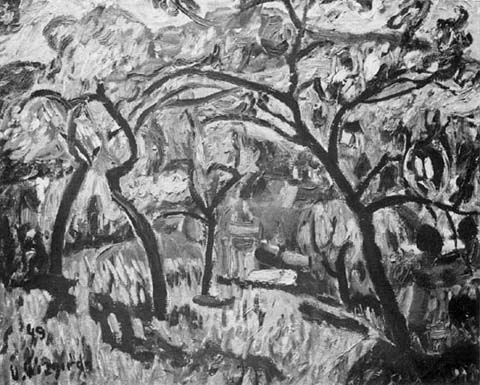
IN THE VALLEY • 1949 •
23"x28¾"
Collection Mr. J. Okunis, New York